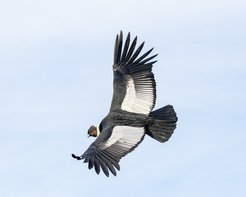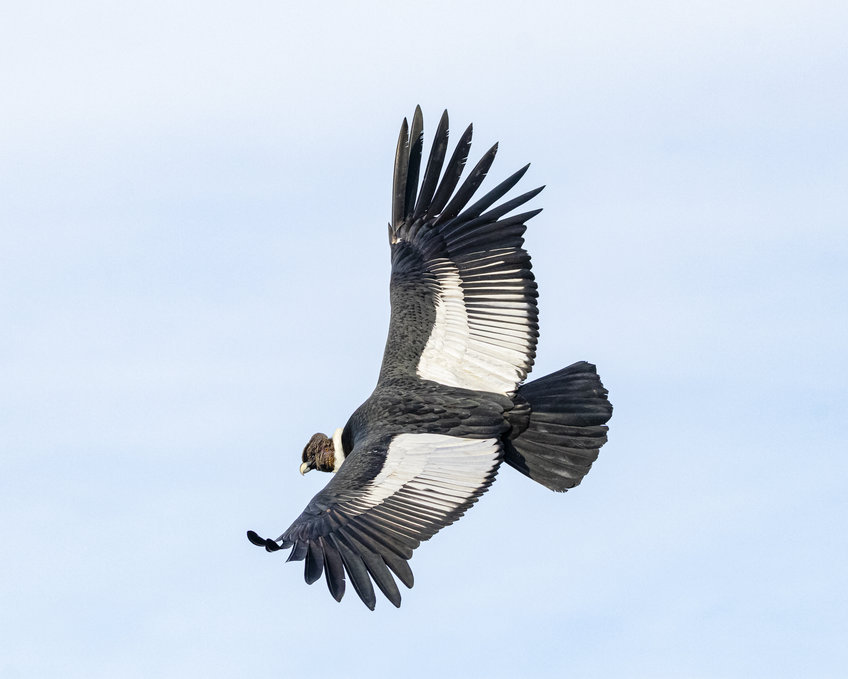El Condor Pasa
High frequency continuous tracking reveals how the world’s heaviest soaring bird stays in flight
Weighing up to 15 kilogram, the Andean condor flies up to five hours continuously without flapping its wings. How can a bird of this weight sustain flights of this length? An international team of researchers, including a postdoctoral researcher now at the Max Planck Institute for Animal Behaviour, have collected high frequency data from wild birds to reveal how one of the most extreme flyers limits their costs of movement. They show that Andean condors make use of air currents to keep them airborne for hours at a time, resorting to costly flapping for only one per cent of flight time. The findings sheds light on the pressures and limitations for movement for all species that use this flight type.

When it comes to flying the largest of birds don’t rely on flapping to move around. Instead they make use of air currents to keep them airborne for hours at a time. The world’s heaviest soaring bird– the Andean condor – actually flaps its wings for one per cent of its flight time.
The study, part of a collaboration between Emily Shepard and Hannah Williams from Swansea University and Sergio Lambertucci in Argentina, uses high-tech flight-recorders on Andean condors. These log each and every wingbeat and twist and turn in flight as condors search for food. The team wanted to find out more about how birds’ flight efforts vary depending on environmental conditions. Their findings will help to improve understanding about large birds’ capacity for soaring and the specific circumstances that make flight costly.
During the study, the researchers discovered that more than 75 per cent of the condors’ flapping was associated with take off. However, once in the sky condors can sustain soaring for long periods in a wide range of wind and thermal conditions - one bird managed to clock up five hours without flapping, covering around 172 kilometers or more than 100 miles.
Avoiding unnecessary landings

Hannah Williams, who helped conduct the research while at Swansea University and is now a postdoctoral researcher at the Max Planck Institute for Animal Behavior, says: “Soaring birds fly under weather conditions that allow them to stay airborne with the absolute minimum of movement costs, but there are times when these birds must resort to extremely costly flapping flight. Our findings suggest that in-flight decisions of when and where to land and when to move between airflows are crucial, as not only do condors need to be able to take off again after landing, but unnecessary landings will add significantly to their overall flight costs.”
Emily Shepard, who is part of Swansea Lab for Animal Movement, said: “Closer examination showed the challenges the birds faced as they moved between weak thermals. The condors were seen to flap more as they reached the end of the glides between thermals, when they were likely to be closer to the ground.” Sergio Lambertucci explained: “This is a critical time as birds need to find rising air to avoid an unplanned landing. These risks are higher when moving between thermal updrafts. Thermals can behave like lava lamps, with bubbles of air rising intermittently from the ground when the air is warm enough. Birds may therefore arrive in the right place for a thermal, but at the wrong time.”
In light of these findings, Williams plans to further investigate the in-flight decision-making process made by condors to understand just how these birds are able to locate the invisible airflows that allow for the absolute minimum of movement costs. While at the Max Planck Institute of Animal Behavior, she will question whether condors, and other animals that depend on airflows to move, can observe the flight of others to essentially ‘map’ their environment. “Using this map, can they ‘up-the odds’ of making efficient movement decisions, and decide when and where to move to without costly mistakes?” Williams says. “In this way we can understand one of the reasons why individuals may move together through space.”













